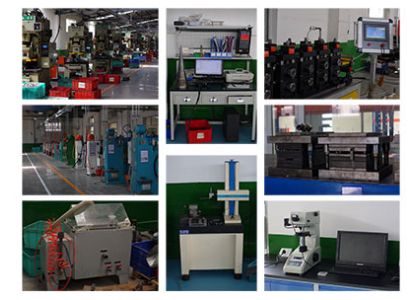
As one of the most professional hose clamp suppliers in China, we have a series of professional and advanced production equipment. The equipment required by hose clamp manufacturers needs to cover the entire process of raw material processing, component molding, assembly and quality inspection. The following is a list of core equipment classified by process, taking into account different production scales and process requirements:
1. Raw material processing equipment
Used to cut coiled steel plates into steel strips of specified width (such as 12-20mm wide), with an accuracy of ±0.1mm.
Correct the bending deformation of the steel strip to ensure the accuracy of subsequent stamping.
Cold drawing of stainless steel or carbon steel wire to improve material strength and surface finish (for worm raw materials).
2. Core component forming equipment
Punching machine (punch press)
Equipped with special molds to complete steel strip punching, slot punching (American throat clamp), folding (German throat clamp edge curling) and other processes, the tonnage is usually 20-60 tons.
Bend or curl the edge of the steel strip. Some German-style hose clamps need to be bent multiple times to form a rubber gasket slot.
Galvanizing line (hot-dip galvanizing or electrogalvanizing): rust-proof treatment of carbon steel strip;
Polishing machine/passivation tank: polish or passivate stainless steel strip to improve corrosion resistance.
Cold heading machine
Multi-station cold heading machine (such as 3-5 stations) is used for one-time forming of worm head (cross groove, slot) and thread segment, with high efficiency (50-100 pieces can be produced per minute).
Lathe (auxiliary)
Used for small batch or non-standard worm processing, with higher precision.
Heat treatment equipment
Mesh belt quenching furnace + tempering furnace: quench (820-860℃) and temper the carbon steel worm to increase hardness (HRC 30-40).
Thread rolling machine
Thread rolling of the worm thread to ensure that the pitch and tooth depth meet the standards (such as ISO 262).
3.Component assembly and debugging equipment
The high-end production line uses fully automatic equipment to realize the integration of steel belt feeding, worm insertion, spring washer installation, and pre-tightening, with an efficiency of 20-30 pieces per minute.
Use simple tooling to assist assembly in small-scale production, such as worm positioning fixtures and steel belt pre-bending molds.
Torque wrench or torque tester: Check whether the tightening torque of the hose clamp meets the standard (such as American 15-30N·m, German 20-40N·m).
4. Surface treatment and protection equipment
Automatic spraying line: Spray anti-rust paint or Dacromet coating on carbon steel hose clamps, and the salt spray resistance test needs to be ≥500 hours.
Automatically apply molybdenum disulfide grease to the worm thread to ensure smooth tightening.
Improve the surface finish of stainless steel hose clamps through electrolytic process and reduce the surface roughness to below Ra 0.8.
Dimension inspection tools
Vernier caliper, micrometer: measure the thickness of steel strip (±0.05mm), worm diameter, etc.;
Projector/image measuring instrument: detect the hole position and slot accuracy of stamping parts.
Sealing test bench: simulate the working condition of hose, pass compressed air (0.6MPa) to detect the leakage;
Vibration test bench: simulate transportation or working condition vibration, and detect the anti-loosening ability of throat clamp.
Rockwell hardness tester: detect the hardness (HRC) of worm after heat treatment.
Mold processing equipment
Wire cutting machine, EDM forming machine: used for the processing and maintenance of stamping dies and cold heading dies.
Storage and packaging equipment
Automatic sorting machine, counting and packaging machine: pack hose clamps according to specifications and print batch labels (including material, specifications, and production date).
Equipment selection suggestions
By reasonably configuring the above equipment, hose clip manufacturers can achieve full process control from raw materials to finished products, and at the same time, they need to adjust the equipment accuracy and automation level according to the product positioning (civilian grade/industrial grade).